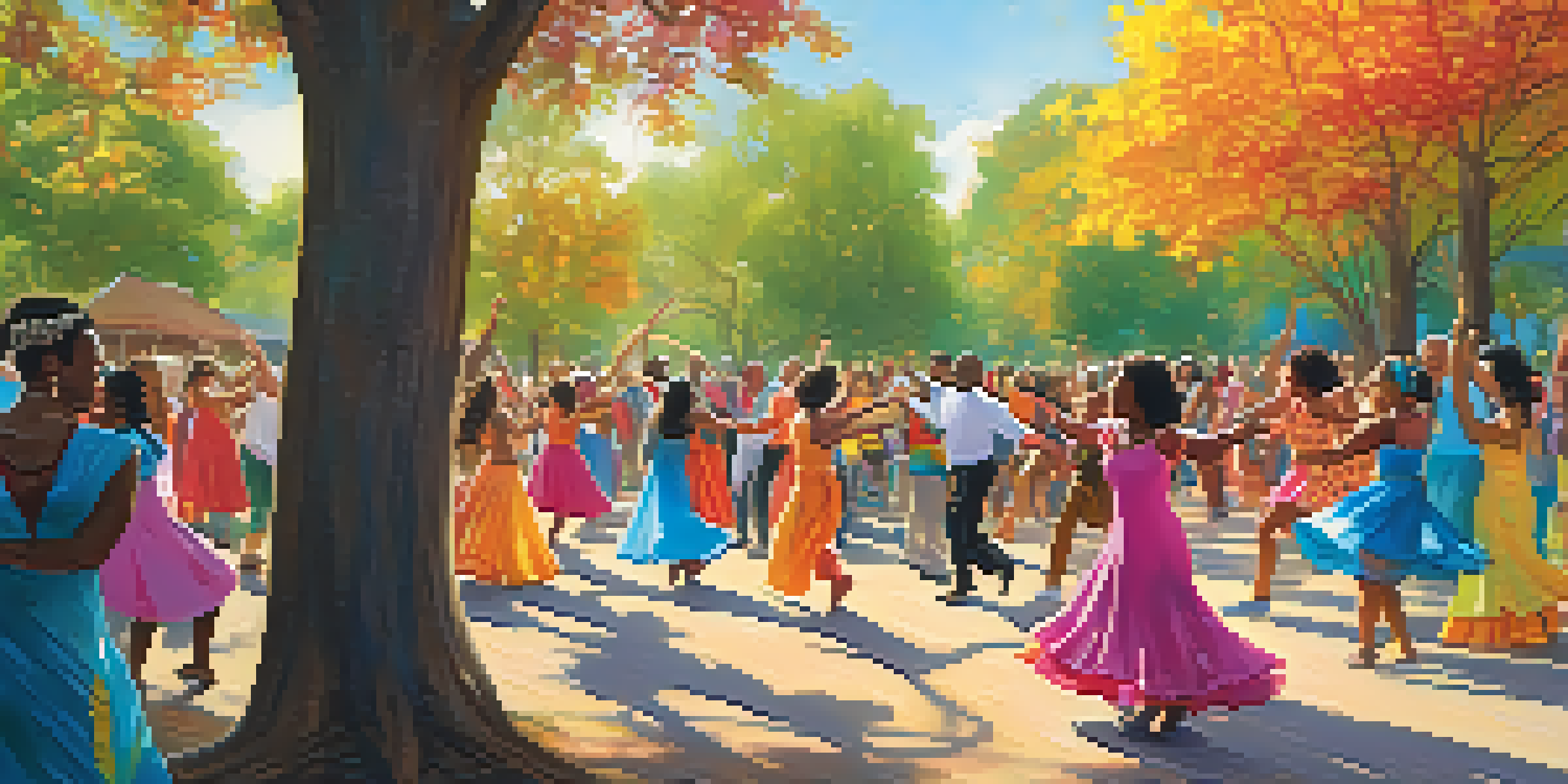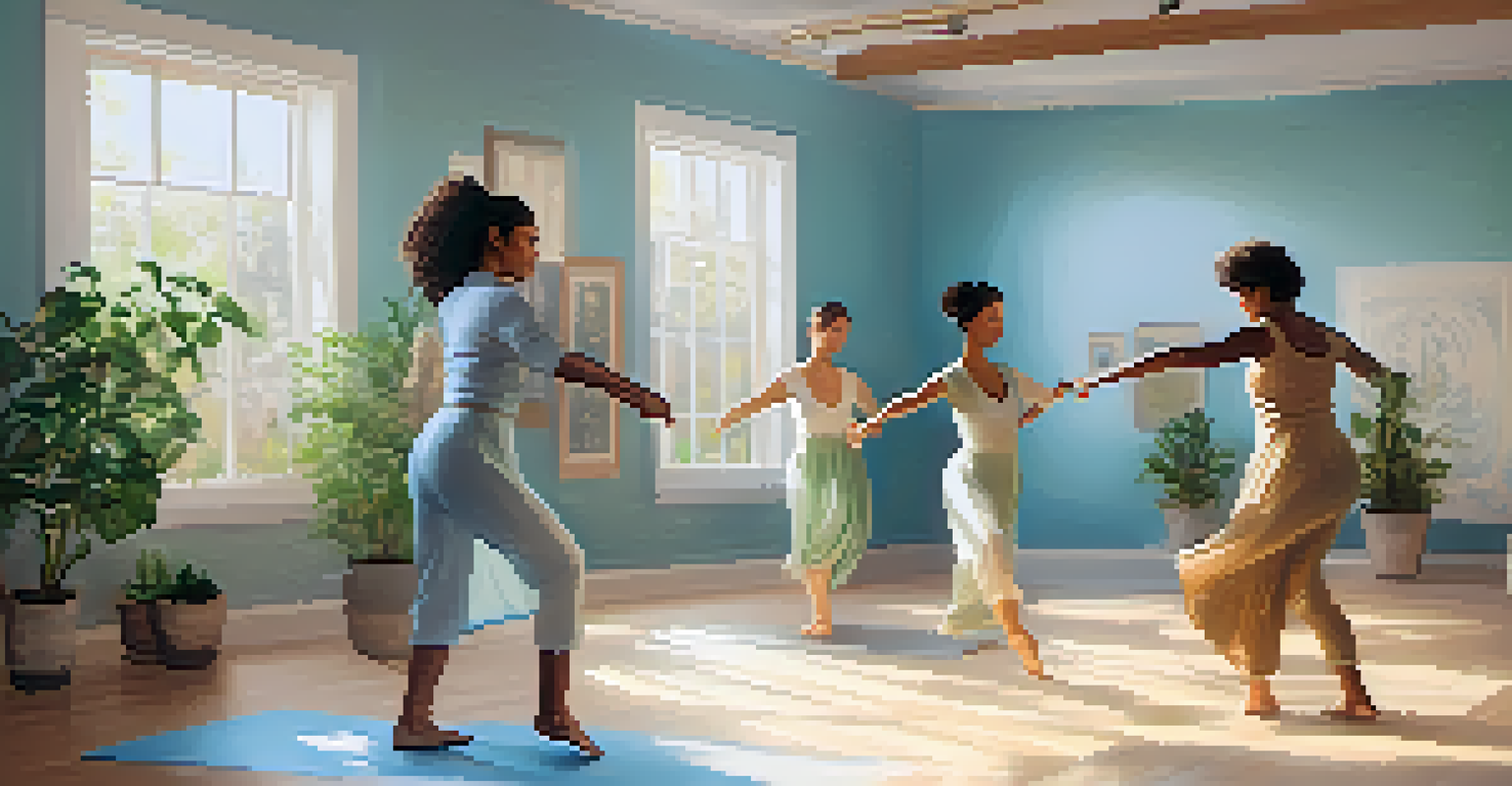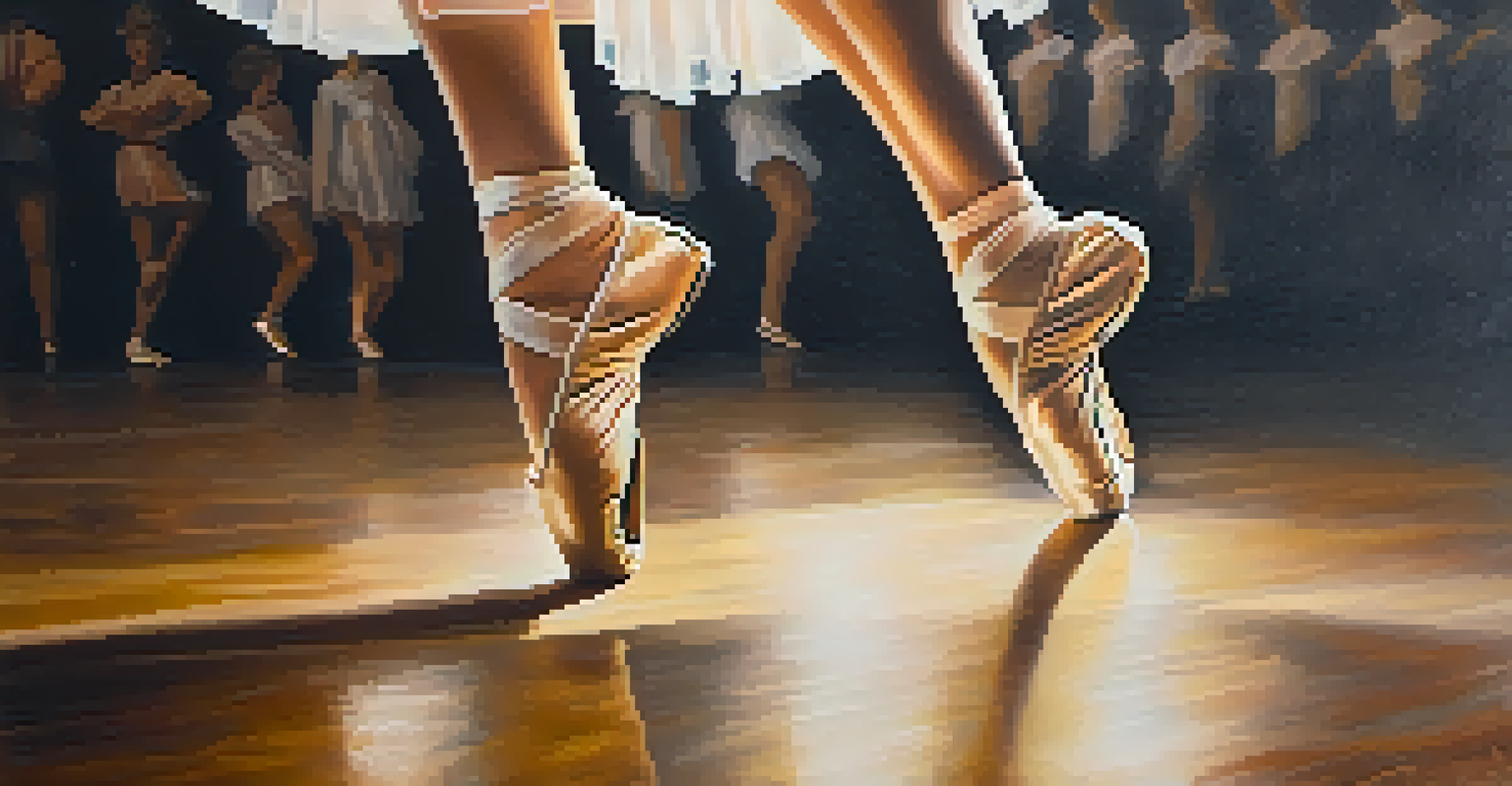How Dance Fosters Social Connections and Mental Well-being

Dance: A Universal Language of Connection
Dance transcends linguistic barriers, allowing people from diverse backgrounds to connect. Whether it's a salsa class or a traditional folk dance, the rhythm invites participation and fosters a sense of belonging. When we dance, we express emotions that words sometimes cannot capture, creating an instant bond with others. This shared experience can lead to meaningful relationships, reinforcing the idea that we are all part of something larger.
Dance is the hidden language of the soul.
Consider a group of strangers coming together for a community dance event. As they learn the steps and synchronize their movements, laughter and smiles abound, breaking down social barriers. In these moments, the dance floor becomes a safe space where individuals can let go of their inhibitions and connect with others in a supportive environment. Such interactions reinforce our innate desire for community and belonging.
Moreover, dance can be a catalyst for lifelong friendships. Many people find their closest friends in dance classes or groups, where shared experiences create cherished memories. These connections often extend beyond the dance floor, as participants bond over their shared passion, highlighting how dance fosters not just social connections but also lasting relationships.
The Mental Health Benefits of Dance
Engaging in dance is not just fun; it also offers significant mental health benefits. Research shows that physical activity, including dance, releases endorphins, the body's natural mood lifters. This release can help reduce feelings of anxiety and depression, making dance an effective tool for emotional well-being. The joy of moving to music can elevate spirits and provide an escape from daily stressors.

Additionally, dance encourages mindfulness, a practice that focuses on being present in the moment. When dancing, individuals often immerse themselves in the rhythm and movements, which helps distract from negative thoughts and worries. This state of flow enhances mental clarity and promotes a sense of peace, allowing dancers to experience a break from their everyday challenges.
Dance Connects People Universally
Through shared movement and rhythm, dance fosters connections and builds a sense of community among diverse individuals.
Furthermore, participating in group dance activities can combat feelings of isolation. Many individuals struggling with mental health issues may feel disconnected from others, but dance creates a supportive community. By engaging in shared movements and rhythms, individuals not only improve their physical fitness but also nurture their mental resilience and social support systems.
Building Confidence Through Dance
Dance provides a unique platform for individuals to build their self-esteem and confidence. As dancers learn new moves and routines, they experience a sense of accomplishment that boosts their self-worth. The act of performing, whether in front of an audience or simply in class, can also empower individuals to embrace their bodies and showcase their talents without fear of judgment.
The dance is a poem of which each movement is a word.
Imagine a shy person stepping onto the dance floor for the first time. With each step and every encouraging smile from fellow dancers, they gradually shed their self-doubt. This transformation not only enhances their dancing skills but also translates into greater confidence in other areas of life. When individuals feel good about themselves, they are more likely to engage socially and pursue new opportunities.
Moreover, dance promotes body positivity, encouraging participants to appreciate their unique movements and rhythms. In a world where societal standards of beauty can be overwhelming, dance celebrates individuality and self-expression. This acceptance fosters a positive self-image, allowing individuals to embrace who they are and connect more authentically with others.
Social Events: Dance as a Community Builder
Dance has long been a central feature of social gatherings, from weddings to cultural festivals. These events not only celebrate traditions but also strengthen community ties through shared experiences. When people come together to dance, they create a collective memory that fosters a sense of unity and belonging, essential for a thriving community.
For instance, consider a local dance festival where families and friends gather to enjoy performances and participate in workshops. The atmosphere is filled with laughter, music, and movement, creating an environment ripe for connection. Participants often leave these events feeling uplifted and inspired, having forged new friendships and deepened existing ones.
Dance Enhances Mental Well-being
Engaging in dance releases endorphins and promotes mindfulness, contributing to improved mental health and emotional resilience.
Furthermore, such social events can serve as a platform for cross-cultural exchange. When different communities come together to share their dance styles, they not only learn about each other's cultures but also build bridges of understanding and acceptance. This rich tapestry of shared movement fosters respect and celebration of diversity, reinforcing the importance of community connections.
Dance Therapy: Healing Through Movement
Dance therapy is a recognized form of expressive therapy that harnesses the power of movement to promote healing and well-being. Licensed dance therapists use movement to help individuals explore emotions, improve cognitive functioning, and enhance social skills. This therapeutic approach can be particularly beneficial for those dealing with trauma, grief, or mental health challenges.
During dance therapy sessions, participants are encouraged to express themselves through movement, which can lead to profound emotional release. This process allows individuals to confront and process their feelings in a safe and supportive environment. By expressing emotions through dance, many find it easier to articulate their thoughts and experiences, paving the way for healing.
Moreover, dance therapy can foster a sense of community among participants. Sharing personal stories through movement creates connections and empathy, reminding individuals that they are not alone in their struggles. This supportive atmosphere not only aids in personal growth but also strengthens social bonds, highlighting the dual role of dance as a therapeutic and social connector.
The Science Behind Dance and Well-being
Numerous studies have explored the relationship between dance and mental health, revealing compelling evidence of its benefits. For example, research indicates that regular participation in dance can reduce symptoms of anxiety and depression while enhancing overall mood. These findings underscore the powerful impact that movement has on mental well-being, making dance an accessible form of therapy for many.
Additionally, the social aspect of dance plays a crucial role in its positive effects on mental health. Engaging with others in a dance setting can combat loneliness and foster a sense of belonging, which is vital for emotional health. The combination of physical activity and social interaction creates a holistic approach to well-being that many find beneficial.
Dance Builds Confidence and Self-esteem
Learning and performing dance routines empower individuals to embrace their bodies, boost self-worth, and promote body positivity.
Furthermore, the release of neurotransmitters during physical activity, such as serotonin and dopamine, contributes to the feelings of happiness and satisfaction that dancers often experience. This biochemical response reinforces the idea that movement is not just a physical act but also a means to enhance mental health, making dance an essential component of a balanced lifestyle.
Getting Started: Embrace Dance for Your Well-being
If you're intrigued by the idea of dance as a means to foster connections and improve mental well-being, starting can be simpler than you think. Look for local classes or community events that cater to all skill levels, ensuring everyone feels welcome. Dance styles range from ballroom to hip-hop, so there's something for everyone, regardless of age or experience.
Joining a dance class or group can be a fantastic way to meet new people and build friendships. Plus, the shared learning experience creates a natural environment for connection and support. As you practice and progress together, the bonds formed can lead to lasting friendships that extend beyond the dance floor.

Remember, the most important part of dancing is to enjoy yourself! Let go of self-consciousness and embrace the joy of movement. Whether you're dancing alone in your living room or in a group setting, the benefits to your social life and mental health are undeniable. So put on your favorite music and let the rhythm guide you!